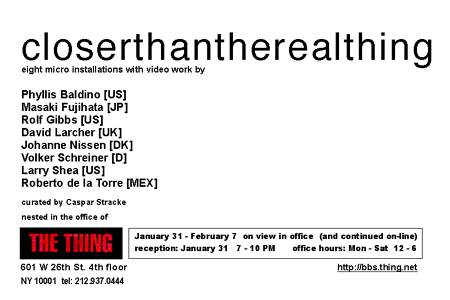
The way we see images in the digital realm is crucially influenced by the
compromise of reduction of scale and resolution. That is to say, compared to
analog photography, digital visual information appears compressed: flattened and
reduced in color, detail, and resolution. Viewers have accepted digital image
compression as unavoidable, and sometimes it even goes unnoticed. But why this
unquestioning acceptance of quality loss in a world of perpetual technological
improvement? To what kind of imagery does this apply? In general this
carelessness with regard to quality might have to do with the natural repetition
of structures and signifiers, here in particular the familiarity of all
appearances that belong to the mainstream urban environment. Most of the images
we consume are figurative in nature -- things one has seen a million times
before. In a subconscious cognitive process, details of images recalled from
memory are superimposed onto what we actually perceive.
However, from an aesthetic viewpoint raises another
question: How much compression in digital imagery can be tolerated before an
image's expression and meaning are unacceptably compromised? The forced
reduction of details in digital media is a well known restraint, one that
artists have often utilized and contextualized with a certain aesthetic pleasure.
Besides Webcam users, Palm Pilot filmmakers and VJ's now, even traditional film
makers have found new ways to approach compressed, streaming video. A common
antidote to the limitations of image compression is a new spatial intimacy with
the medium. Many makers have simply moved objects (or sometimes body parts) a
bit closer to the lens and therefore ask the viewer to move closer to the
screen. A video that is intended to be seen on a small screen reflects
something lively when showing objects life-size or larger -- closer than the
real thing.
The work of eight international video artists will be exhibited on small-scale
monitors/projections placed in various locations in THE THING's office, which
will serve as the exhibition space for this week-long show. The theme of scale
and closeness rages from observations of statically-charged water drops (Larry
Shea) to witnessing a free fall from a 30,000-foot height all the way to the
ground (Rolf Gibbs).
As temporal micro installations, in windows or on shelves, tables, or the floor,
etc., the videos will be placed such that the location responds to the work's
content. After a week on display all videos will be encoded and moved onto the
local server (in the same office) where the exhibition will continue on-line.
De-installation and encoding will be video taped and this documentation will be
presented as part of the exhibition in THE THING's video archive as well.

